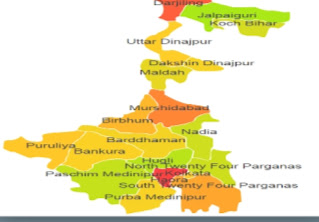Per capita income and other growth rate during 2011to 2019
The All India Trinamool Congress (AITMC), popularly known as the Trinamool Congress (TMC), has been at the helm of West Bengal’s political landscape for several years. Let’s delve into the economic and social scenario during the Trinamool Congress regime compared to the Left Front regime from 12 years ago.
Economic Landscape:
Per Capita Income Growth:
During the Trinamool government (2011-2019), West Bengal’s per capita income growth rate not only remained lower than the growth rate of the previous decades under the Left-led regime but also declined below the national average.
During the Trinamool regime (2011-2019), West Bengal's per capita income growth rate was 4.2%, compared to 4.9% between 2000 and 2010.
This suggests that the economic progress during the Trinamool Congress era was relatively sluggish compared to earlier periods.
Sectoral Analysis:
Agriculture: West Bengal witnessed a 3.3% growth in agriculture during the Trinamool regime, surpassing the national average of 1.6%.
The agricultural growth rate during 2011 to 2019 was 2.9%,surpassing the national average of 1.6%. while it was 3.1% between 2000 and 2010.
This also suggests that the agricultural growth rate during the Trinamool Congress era was relatively sluggish compared to earlier periods led by left front.
However, the other two sectors—industry and services, which significantly contribute to modern economies—experienced a decline in growth.
Despite this, the rural per capita expenditure increased, and poverty levels decreased sharply, indicating a focus on rural development and welfare schemes1.
Unemployment Rate:
During the Left Front regime (2000-2010), West Bengal's unemployment rate was 3.3%, while under the Trinamool regime (2011-2019), it was 4.6%.surpassing the national unemployment rate of 6.51%.
The State’s unemployment rate in both rural and urban regions was lower than the national average during the Trinamool Congress rule.
Resource Allocation:
The government redirected resources toward agricultural and rural development, benefiting the rural population, which constitutes a majority (70%) of West Bengal’s inhabitants
Social Welfare and Political Society:
Welfare Schemes:
Despite limited financial resources, the Trinamool Congress government prioritized social welfare schemes.
These schemes contributed to an increase in rural per capita expenditure and a decline in poverty levels.
Political Society:
The success of welfare programs depends on effective implementation.
The formation of cadre organizations to distribute and address grievances related to these schemes played a crucial role.
An interdependent relationship between the informal sector and welfare schemes emerged, securing the party’s vote share
In summary, while the Trinamool Congress regime focused on rural development and welfare, the economic growth rate remained modest. The party’s strategies, including effective welfare implementation, contributed to its sustained influence among the people of West Bengal. The political landscape continues to evolve, with both challenges and opportunities for the state’s future.
Data retrieved from net.. For comments please write to ujjwal.sarkar@gmail.com


Comments
Post a Comment